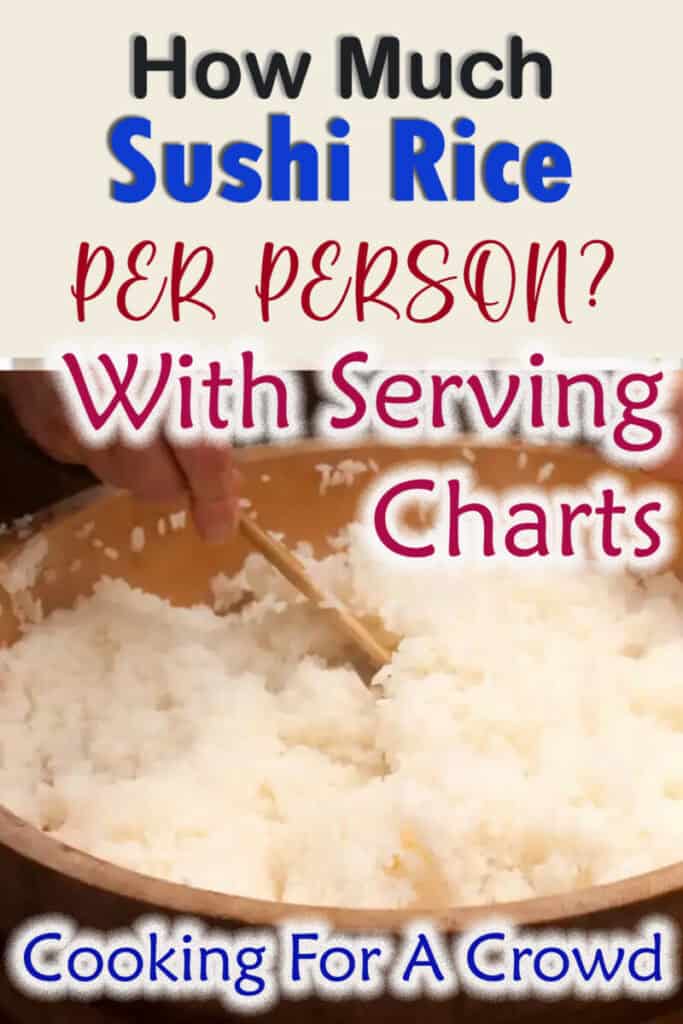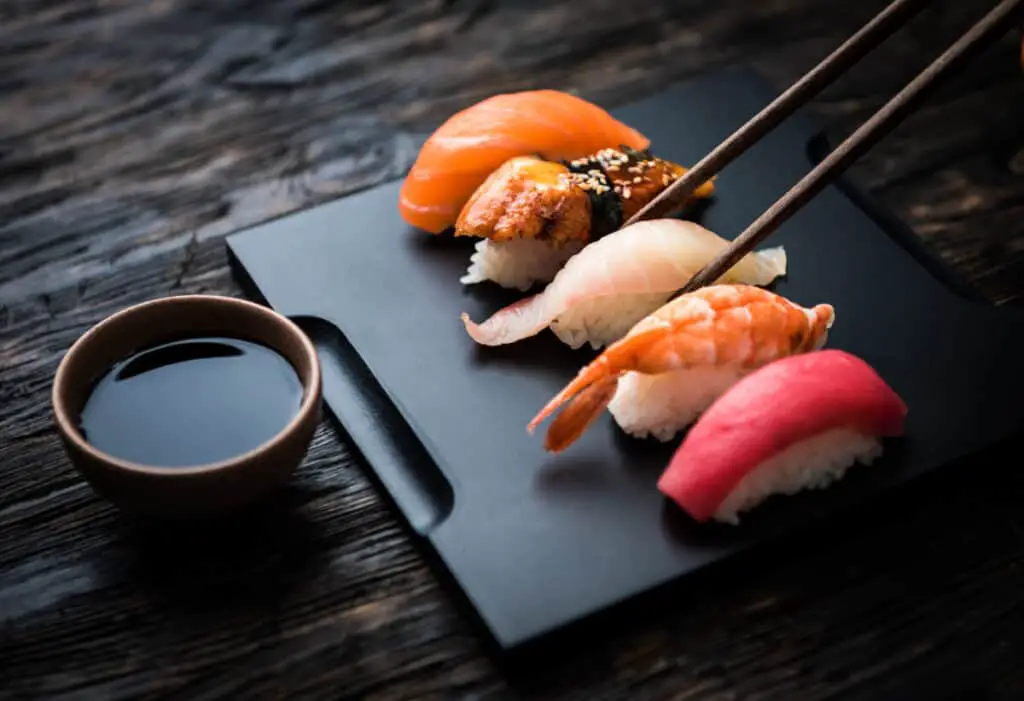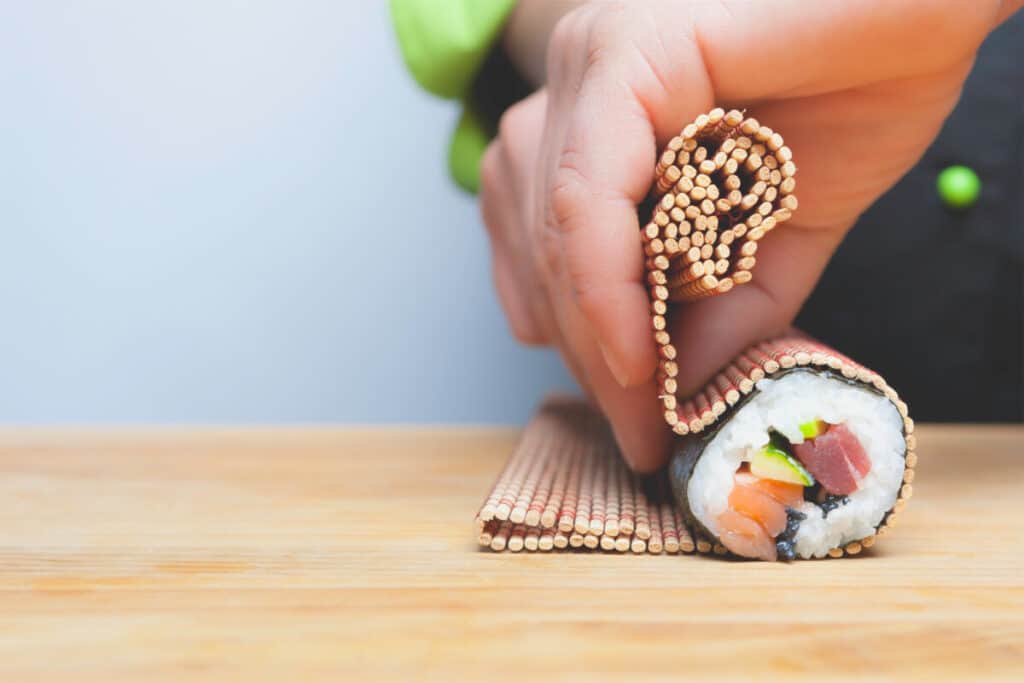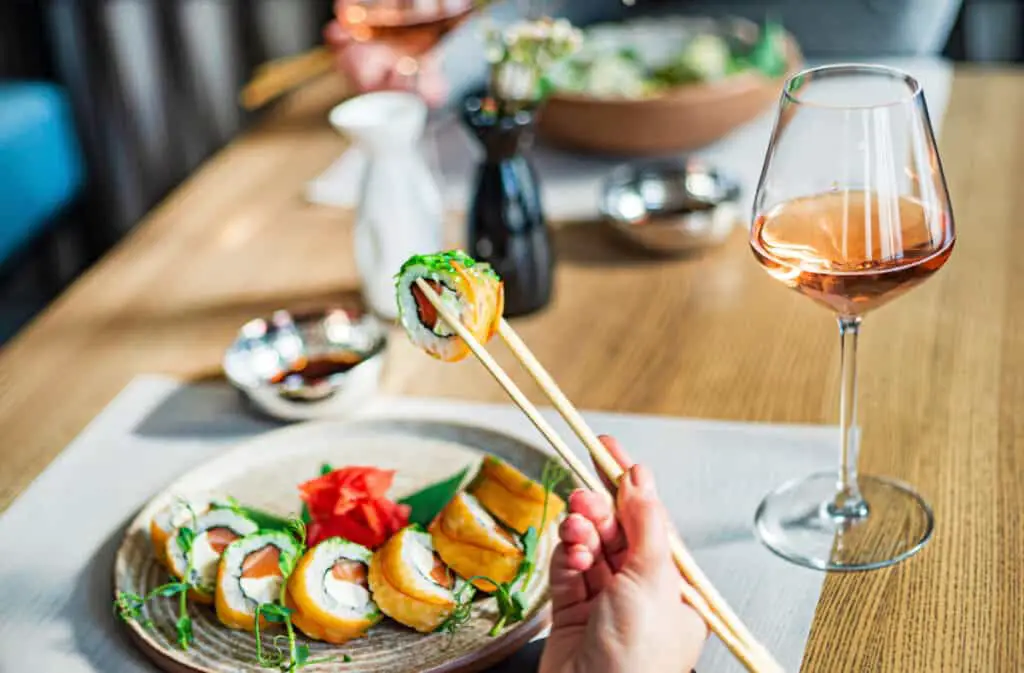This post contains affiliate links.
Sushi is a simple meal that many can enjoy. It is customizable enough to cater to different pallets and filling enough to satisfy. But how do you know how much rice to cook? How much will each person need?

The average amount of sushi rice to prepare per person is six to nine ounces. One person on average will eat about two to three rolls of sushi. The average sushi roll contains around three ounces of sushi rice while this number varies from person to person due to individual preferences.
That being said, there is much to consider when preparing food for a larger group of people. Let’s dive into what else to keep in mind when preparing this sushi meal.
How Much Sushi Rice Per Person

When preparing to make sushi, it is important to measure how much sushi you will need per person so you aren’t wasting any and you aren’t doing more or less work than necessary. The chart below shows how much sushi you will need in various circumstances that will be having changing amounts of people that will lead to needing to know how much sushi rice will be needed to make.
| Amount of People | Amount of Rice Two Rolls Each | Amount of Rice Three Rolls Each |
| 10 people | 60 ounces (3.75lbs) | 90 ounces (5.5lbs) |
| 25 people | 150 ounces (9.5lbs) | 225 ounces (14lbs) |
| 50 people | 300 ounces (18.75lbs) | 450 ounces (28lbs) |
| 100 people | 600 ounces (37.5lbs) | 900 ounces (56.25lbs) |
| 200 people | 1200 ounces (75lbs) | 1800 ounces (112.5lbs) |
While having the chart above to refer to when measuring out how much sushi rice will be needed for a set number of people, you may not always have access to the chart. That being said, in the case that this chart is not available to you for reference, a good rule of thumb would be to remember that for 10 people you need a little less than 4 pounds of sushi rice. From there it is simply basic math.
By taking the total number of people that you are feeding and multiplying that number by 6 or 9, you can then get the number that will tell you how many ounces of rice will be needed to make the desired amount of sushi rice. Some people might desire to eat more than others, and while that is fine, it is important to account for those people.
While careful calculation will help you to decrease the chances of wasting ingredients by giving you more precise measurements, it is always helpful to have a little more than necessary on hand as you make the sushi rice in case the guests eat more than the exact serving sizes that were prepared.
This is why the option of three rolls per person and the measurements for that are also given. Playing around with the numbers given and finding out how much you think each person will need is a great starting point. From there you can gauge adults versus children and who will eat how much, and approximate a much better number with that.
What Dishes To Make With Sushi Rice
Contrary to its name, sushi rice is not only meant for sushi. It can also be used to prepare a variety of dishes that originate from all across the world.
One dish you can make with sushi rice is called “congee”. This dish is easy to make, especially if you have leftover rice that didn’t get used for a previous dish, this dish is best when leftover rice is used. By adding some stock, pepper, ginger, chicken powder, and then let it warm on the stove for about 15 minutes, “congee” is an easy, delicious way to use leftover rice and experience a popular dish from the Malaysian culture.
A second dish that sushi rice is a good candidate for is what is called “suppli”, otherwise known as risotto balls. This Roman dish mixes mozzarella cheese, a beaten egg, shredded pork, and tomato risotto. You will then simply roll the leftover rice into a ball and roll it in the mixture as well as breadcrumbs. Cook them in a pan with hot oil until they are golden and crispy. The sticky consistency of the sushi rice is helpful for this dish, as it helps the rice hold its shape as you prepare and cook it.
The other dish that is an option is a sweeter dessert with the main ingredient being rice. Baked rice pudding is easy, delicious, and it is likely that already have all the necessary ingredients in your kitchen. All you need is your sushi rice, milk, cream, eggs, and sugar, mix them together and bake at 150 for 10-15 minutes and you have yourself a tasty dessert and have put that leftover sushi rice to good use.
Because rice is a universally enjoyed food around the globe, there are endless ways and recipes to use your leftover sushi rice.
Sauces To Add to Sushi Rice

Some sauces are better for certain dishes than others, and sushi rice is no different. While there are the traditional sauce options such as soy sauce and sriracha, there are other sauce recipes that you may like to try to add some variety to your sushi rice sauce selections.
The first sauce is Eel sauce. This sauce is typically used on sushi rolls that contain eel. The name initially may turn some away from this sticky, sweet sauce, but once you learn how simple it is to make you will be adding this sauce to all your sushi rolls. To make eel sauce you’ll need soy sauce, granulated sugar, and Japanese sweet wine. Just by combining these three ingredients in a pan on the stove and warming them to a soft simmer, you have yourself some eel sauce.
The second sauce is Dynamite sauce. This sauce is the most generic of the three and is the most popular among the spicy sauces of choice to add to your sushi rice. The recipe for this sauce is a two-ingredient recipe that includes both sriracha and mayonnaise and does not require any cooking or chilling time unless you desire your sauce to be cold when you serve it. Just mix the two ingredients and that is the way to make the infamous dynamite sauce.
The last sauce that you could add to your sushi rice is a sweeter option if you prefer to stay away from the spice that a lot of sushi sauces have. Mango sauce is not a commonly served sauce in many restaurants because it is considered a delicacy of sushi sauces. It is most popular on either tuna or crab rolls. To make this sauce you’ll need rice vinegar, granulated sugar, salt, vegetable oil, and of course, a ripe mango. You will heat all the ingredients besides the mango and then once that mixture is heated, chop up the mango and mix the chunks with the cooled mixture and you’re mango sauce is ready to go.
Regular Rice vs. Sushi Rice

While many may assume that sushi rice is regular rice that is used for sushi, there is in fact rice that is specifically used for sushi. Although it is always up to the cook’s discretion of deciding which type of rice to use in whatever dish they may be making, know that sushi rice is specifically meant for sushi and can be interchanged for regular in other dishes. Regular rice is not interchangeable for sushi. There is reasoning and purpose behind why specifically sushi rice is used as opposed to using regular rice.
While there are many similarities between the two kinds of rice, there are differences that make sushi rice a better candidate for being used for sushi.
Some of the differences between the two kinds of rice include texture. Sushi rice is sticky and mouldable, while regular rice is dry and doesn’t have the ability to form into the rolled shape that is necessary for sushi that sushi rice does. Another difference is the way that they each are cooked. Sushi rice is steamed, while regular rice is cooked. Sushi rice is also short-grain rice, while regular rice is either medium-grain or long-grain. Sushi rice is more translucent than regular rice, which has less transparency.
Additionally, some other differences include the way the rice is served. Sushi rice is traditionally served seasoned with either vinegar, salt, or sugar, while regular rice is served plain with no seasonings added to it. Knowing how the rice is typically served can also help you determine whether or not it would be a proper substitute for other dishes that don’t traditionally use that type of rice.
Drinks To Serve With Sushi Rice

When you are selecting drinks to present as options to accompany your sushi rice, in either a sushi roll or by itself, you want to have choices that will rather enhance the flavor of your meal, rather than take away from it. It is up to the individual whether that drink is alcoholic or non-alcoholic, however, we will be discussing options for either choice.
First, are some alcoholic options. The important thing to remember when selecting either a beer or a wine for your meal is that you want a wine that is more of “dry” wine, meaning having a weaker flavor. Doing this will allow you to still enjoy your wine, while also being able to experience all the flavors that your sushi has to offer.
If you choose to drink beer alongside your sushi rice, some good pairings would include Asahi, Sapporo, Kirin, or Coors Light. If you prefer wine, some options would be Sauvignon Blanc or Chardonnay. If you are feeling fancy and choose to have a mixed drink, Domo Arigato or Mezcal Drinks are options that won’t take away from your sushi experience.
Next are the non-alcoholic drink options. The two options that are best are either ginger ale or green tea, specifically Asian green tea. Or you always have the option of water if you so choose. Any of these non-alcoholic options would be perfect complements to your sushi rice meal.
What Are The Best Brands of Sushi Rice
Just as we discussed regarding sauces about the fact that there are better options than some, the same thing applies to the brand of rice you choose when making sushi. There are lots of different brands of sushi rice you could choose from and that could get overwhelming in deciding which one to use for your sushi. We are going to discuss a few different brands that should give you a good start in deciding which brand you like best.

The first brand is Koshikikari. Koshikikari is a Japanese rice that was first planted and discovered in Japan in 1956 but now is also grown and produced in the United States. It is a quality rice brand for sushi specifically because of it being a short grain, as well as its sticky consistency when steamed.
The second brand we are going to discuss is Tamanishiki, or it is also called Tamaki Gold. This brand is high-quality, short-grain rice, that was first planted in California. This is a popular brand among highly respected restaurants all over the country.
The next brand we’ll talk about is Lundberg Family Farms Organic Sushi Rice. Also grown and developed in California, it is a great option for those who are gluten intolerant, as it is a gluten-free rice. In addition to being gluten-free, it is also non-GMA and certified by the USDA as organic.
The last brand is RiceSelect Sushi Rice. This brand is different than the others in the sense that it has a more sweet taste, which would make it more applicable to dishes such as rice pudding, rather than sushi.
All of these brands are high-quality, well-produced, and work well for any sushi or other rice dishes. The caveat that would be included is that using any of these brands is not one-size-fits-all, so it is important to try a different brand for different dishes and find your favorites through trial and error.


